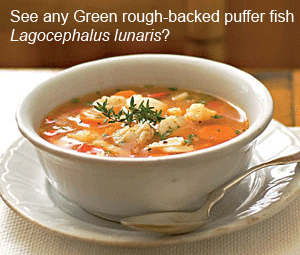What fish is that you are eating? This question has many possible answers. Unlike meats, which are derived from a handful of species, most of which are farmed, there are numerous fish sold for human consumption, most of which are wild. The US FDA Regulatory Fish Encyclopedia and the Canadian Food Inspection Agency lists of approved fish and shellfish include approximately 1700 and 660 names, respectively. And yet DNA surveys regularly turn up fish in the marketplace that are not on any regulatory list, as well as mislabeling of those that are listed, suggesting we may not know what we are eating or what fish stocks are being harvested.
 In addition to economic and environment impact, mislabeling can have public health implications. In April 2009 J Food Protection government and research scientists report on 2 cases of tetrodotoxin poisoning in Chicago, IL resulting from ingestion of soup prepared from mislabeled puffer fish, sold as “monkfish.” Two additional cases were traced to the same supplier and this led to the recall of several thousand pounds of frozen fish. Morphologic examination of leftover parts and DNA testing of the cooked meat implicated Lagocephalus sp., most likely Green roughed-back puffer L. lunaris. Unlike most other toxic puffer species, L. lunaris tetrodotoxin is in muscle as well as organ tissue, making safe preparation impossible. At the time of the study, there were no reference sequences in BOLD for L. lunaris, so the DNA barcode identification was incomplete. It would be of interest to repeat the database searches (as of today GenBank contains 1 L. lunaris COI sequence and BOLD taxonomy browser lists 2), but for some reason the sequences obtained by the researchers were not published.
In addition to economic and environment impact, mislabeling can have public health implications. In April 2009 J Food Protection government and research scientists report on 2 cases of tetrodotoxin poisoning in Chicago, IL resulting from ingestion of soup prepared from mislabeled puffer fish, sold as “monkfish.” Two additional cases were traced to the same supplier and this led to the recall of several thousand pounds of frozen fish. Morphologic examination of leftover parts and DNA testing of the cooked meat implicated Lagocephalus sp., most likely Green roughed-back puffer L. lunaris. Unlike most other toxic puffer species, L. lunaris tetrodotoxin is in muscle as well as organ tissue, making safe preparation impossible. At the time of the study, there were no reference sequences in BOLD for L. lunaris, so the DNA barcode identification was incomplete. It would be of interest to repeat the database searches (as of today GenBank contains 1 L. lunaris COI sequence and BOLD taxonomy browser lists 2), but for some reason the sequences obtained by the researchers were not published.
DNA testing is the only way to identify many of the fish items in the marketplace. I expect that standardized DNA testing (aka DNA barcoding) will play an increasingly important role in helping protect both consumers and fish.
Wow, this is very interesting to know. I hope that DNA barcoding can continue to help us regulate fish and other meats that may not be healthy for us. That is shady business labeling fish as something else, hope everyone was ok that ate it in the incident you mentioned!